Evolution of the Game Pad
HOME > Computers > Game Pad
I was looking at some classic game console joypads the other day,
and I began wondering how their features developed over the years.
So, here's a first draft of a history of the joypad, in roughly
chronological order.
The TV Tennis Game Paddle
 An analogue control based on the monostable and triggered by
the frame sync pulse.
This particular one with the snazzy orange plastic case is from the
Binatone TV Master MK IV.
Game-start buttons were often located on the console, not on the
paddles.
Some TV games didn't even put the paddles on wires, but placed
them on the front of the game box itself.
One particularly odd machine in this respect was the Videomaster
Superscore, which not only mounted the controls on the front
of the console,
but it also used roller-style controls.
An analogue control based on the monostable and triggered by
the frame sync pulse.
This particular one with the snazzy orange plastic case is from the
Binatone TV Master MK IV.
Game-start buttons were often located on the console, not on the
paddles.
Some TV games didn't even put the paddles on wires, but placed
them on the front of the game box itself.
One particularly odd machine in this respect was the Videomaster
Superscore, which not only mounted the controls on the front
of the console,
but it also used roller-style controls.
 Another slightly strange option was the use of slider controls,
such as those on the Commodore 3000H TV Game.
One slider, labelled ‘Bat Control’ was located on the
console itself, while the other slider was in a separate hand-held box.
My example is a PAL version and is labelled in German as well as English.
Another slightly strange option was the use of slider controls,
such as those on the Commodore 3000H TV Game.
One slider, labelled ‘Bat Control’ was located on the
console itself, while the other slider was in a separate hand-held box.
My example is a PAL version and is labelled in German as well as English.
 Inside the Commodore slider paddle, there's simply a 1MΩ
potentiometer, wired up as a variable resistor.
Two additional sliders connected to a single 5-pin DIN plug for
four-player games.
Inside the Commodore slider paddle, there's simply a 1MΩ
potentiometer, wired up as a variable resistor.
Two additional sliders connected to a single 5-pin DIN plug for
four-player games.
 Generally, with the early TV tennis games, there were no buttons on the paddles.
These paddles were made by Atari and have a side-mounted button as well as
the usual rotary paddle control.
Thanks to Maarten Foukhar for the photo.
Generally, with the early TV tennis games, there were no buttons on the paddles.
These paddles were made by Atari and have a side-mounted button as well as
the usual rotary paddle control.
Thanks to Maarten Foukhar for the photo.
The Atari 2600 Joystick
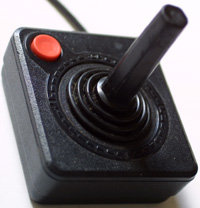 A digital, four-way joystick with a single fire button.
Introduced in October 1977 with the Atari Video Computer System (VCS),
later renamed the Atari 2600.
Set the standard in joysticks and interface connectors for many years.
Again, game-start controls on the console itself.
Need photos: Quick Shot joystick.
A digital, four-way joystick with a single fire button.
Introduced in October 1977 with the Atari Video Computer System (VCS),
later renamed the Atari 2600.
Set the standard in joysticks and interface connectors for many years.
Again, game-start controls on the console itself.
Need photos: Quick Shot joystick.
 Many manufacturers made Atari-compatible joysticks with four direction
switches and a fire button.
Here's an example in clear plastic, where the user can see the four
high-quality microswitches at the bottom of the stick.
Shame they didn't use a microswitch for the fire button, too.
Many manufacturers made Atari-compatible joysticks with four direction
switches and a fire button.
Here's an example in clear plastic, where the user can see the four
high-quality microswitches at the bottom of the stick.
Shame they didn't use a microswitch for the fire button, too.
The Quick Shot VII Joypad
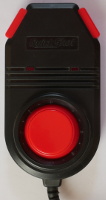 Spectravideo made a wide range of joysticks and other game controllers
under the Quick Shot brand.
This one is the Quick Shot VII, a joystick with a moving pad
instead of a stick.
It also has two shoulder buttons,
but it's not clear how you're supposed to hold it.
Is it intended to be used one-handed?
And which way up does it go?
In addition to the buttons, it has two red LEDs.
I should really plug this one into a console and see what the LEDs do.
Spectravideo made a wide range of joysticks and other game controllers
under the Quick Shot brand.
This one is the Quick Shot VII, a joystick with a moving pad
instead of a stick.
It also has two shoulder buttons,
but it's not clear how you're supposed to hold it.
Is it intended to be used one-handed?
And which way up does it go?
In addition to the buttons, it has two red LEDs.
I should really plug this one into a console and see what the LEDs do.
The Quick Shot IX Joyball
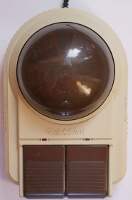 Another from Spectravideo,
this one is the Quick Shot IX, a joystick in the shape of a ball.
It has two buttons in addition to the four-way switches underneath the
ball, which is in fact a hemisphere.
It looks like a trackball, but it isn't.
There's a slide switch on one side that's marked ‘LEFT HAND’
and ‘RIGHT HAND’ -- I presume it swaps the buttons around.
The interface is a 9-pin D-connector like the Atari joystick above,
although I think other models were made with different interfaces.
Another from Spectravideo,
this one is the Quick Shot IX, a joystick in the shape of a ball.
It has two buttons in addition to the four-way switches underneath the
ball, which is in fact a hemisphere.
It looks like a trackball, but it isn't.
There's a slide switch on one side that's marked ‘LEFT HAND’
and ‘RIGHT HAND’ -- I presume it swaps the buttons around.
The interface is a 9-pin D-connector like the Atari joystick above,
although I think other models were made with different interfaces.
The Atari 7800 Joystick
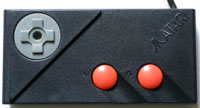 The Atari 7800 controller is a digital, four-way joystick with two fire buttons.
Simply adds an extra fire button to the 2600 joystick.
The wiring is cleverly arranged to maintain compatibility with
the older 2600 joystick, with just a couple of resistors forming
a crude OR gate.
My example is missing the screw-in stick, but still functions
as a joypad.
Buttons are labelled ‘1’ and ‘2’.
The Atari 7800 controller is a digital, four-way joystick with two fire buttons.
Simply adds an extra fire button to the 2600 joystick.
The wiring is cleverly arranged to maintain compatibility with
the older 2600 joystick, with just a couple of resistors forming
a crude OR gate.
My example is missing the screw-in stick, but still functions
as a joypad.
Buttons are labelled ‘1’ and ‘2’.
Oddity: The Foot-operated Joystick
 A peculiar gadget, the QJ Footpedal System was designed to work with
the Atari joysticks and other compatible machines.
It has three foot-operated switches, as well as a set of configuration
switches.
You could set it up to operate a driving game, presumably.
QJ model SV-129, patent pending.
A peculiar gadget, the QJ Footpedal System was designed to work with
the Atari joysticks and other compatible machines.
It has three foot-operated switches, as well as a set of configuration
switches.
You could set it up to operate a driving game, presumably.
QJ model SV-129, patent pending.
The 8-bit Home Computer Joystick
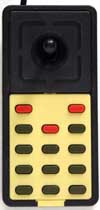 An analog joystick with a single fire button.
Many UK gamers would remember the
BBC
Micro and its 15-pin analog port,
which was usually used for a joystick.
However, other machines had similar (but incompatible) ports,
such as the Dragon 32.
Games were generally started from the
BASIC
interpreter of the machine, using the keyboard.
Need photos: Dragon joystick, Apple ][ paddle.
An analog joystick with a single fire button.
Many UK gamers would remember the
BBC
Micro and its 15-pin analog port,
which was usually used for a joystick.
However, other machines had similar (but incompatible) ports,
such as the Dragon 32.
Games were generally started from the
BASIC
interpreter of the machine, using the keyboard.
Need photos: Dragon joystick, Apple ][ paddle.
The Vectrex Joystick
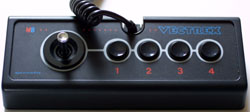 An analog joystick with four buttons.
The Vectrex was an 8-bit, vector-scan console introduced in 1982.
It had two controller ports, and each controller had an analog
joystick (sprung to centre) and four buttons.
The analog-to-digital converter (ADC) for the joystick was located in
the console itself, not in the controller, and two wires carry the analog
signals through the cable to the 9-pin plug.
The function of the buttons was shown on the screen overlay.
Games were started from the controller using the normal fire buttons.
The four buttons are labelled ‘1’ to ‘4’.
An analog joystick with four buttons.
The Vectrex was an 8-bit, vector-scan console introduced in 1982.
It had two controller ports, and each controller had an analog
joystick (sprung to centre) and four buttons.
The analog-to-digital converter (ADC) for the joystick was located in
the console itself, not in the controller, and two wires carry the analog
signals through the cable to the 9-pin plug.
The function of the buttons was shown on the screen overlay.
Games were started from the controller using the normal fire buttons.
The four buttons are labelled ‘1’ to ‘4’.
The Nintendo Entertainment System Joypad
 A digital joypad with two game-start buttons and two fire buttons.
First used on the Nintendo Family Computer of 1983, and later
sold around the world as the Nintendo Entertainment System (NES)
from 1986.
The NES joypad introduces the idea of placing active components
and circuitry inside the joypad.
Each joypad has an 8-bit
CMOS
shift register chip in it (the 4021)
and the console contains hardware to communicate with it.
This reduces the number of wires required in the cable from
nine (one per button, plus ground) to just five.
However, the NES has a seven-pin connector
(the two extra pins were for the light gun).
The shape of the game pad, however, is a very basic rectangular box.
The two fire buttons are both red in colour and are labelled
‘A’ and ‘B’.
A digital joypad with two game-start buttons and two fire buttons.
First used on the Nintendo Family Computer of 1983, and later
sold around the world as the Nintendo Entertainment System (NES)
from 1986.
The NES joypad introduces the idea of placing active components
and circuitry inside the joypad.
Each joypad has an 8-bit
CMOS
shift register chip in it (the 4021)
and the console contains hardware to communicate with it.
This reduces the number of wires required in the cable from
nine (one per button, plus ground) to just five.
However, the NES has a seven-pin connector
(the two extra pins were for the light gun).
The shape of the game pad, however, is a very basic rectangular box.
The two fire buttons are both red in colour and are labelled
‘A’ and ‘B’.
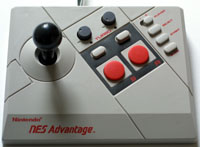 The NES Advantage was a much larger, arcade-style joystick for the NES console.
It has a double cable and can be switched between acting as the
‘Player 1’ controls and the ‘Player 2’ controls.
It also features variable speed auto-repeat on the fire buttons.
The NES Advantage was a much larger, arcade-style joystick for the NES console.
It has a double cable and can be switched between acting as the
‘Player 1’ controls and the ‘Player 2’ controls.
It also features variable speed auto-repeat on the fire buttons.
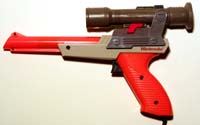 The light gun for the NES was officially called the NES Zapper.
This example has the optional add-on gunsight, clipped on top.
The light gun for the NES was officially called the NES Zapper.
This example has the optional add-on gunsight, clipped on top.
The Sega Master System Joypad
The Sega Master System was a Z80-based console released in 1986, but I don't have one!
Refer to the excellent
Wikipedia article
for more information.
The Super Nintendo Entertainment System Joypad
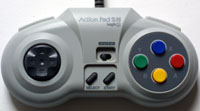 A digital joypad with two game-start buttons and six fire buttons.
The Super Nintendo Entertainment Sysytem joypad extends the
8-bit shift register of the NES to 16 bits,
although only 12 bits were actually used.
Exactly the same interface circuit will read a SNES pad as was
used for the NES, simply clocking the shift register 12 times
instead of eight.
There's also a different connector on the SNES pad, but the same number
of active wires in the cable: five.
It also introduces the idea of shoulder buttons, and it is shaped
much more naturally to fit the player's hands.
A digital joypad with two game-start buttons and six fire buttons.
The Super Nintendo Entertainment Sysytem joypad extends the
8-bit shift register of the NES to 16 bits,
although only 12 bits were actually used.
Exactly the same interface circuit will read a SNES pad as was
used for the NES, simply clocking the shift register 12 times
instead of eight.
There's also a different connector on the SNES pad, but the same number
of active wires in the cable: five.
It also introduces the idea of shoulder buttons, and it is shaped
much more naturally to fit the player's hands.
 Like the NES, an arcade-style joystick was available, called the
Score Master.
This joystick includes the two shoulder buttons of the original,
but moves them into the same group as the main four fire buttons.
The fire buttons retain their usual colour coding, while the two shoulder
buttons are grey.
Like the NES, an arcade-style joystick was available, called the
Score Master.
This joystick includes the two shoulder buttons of the original,
but moves them into the same group as the main four fire buttons.
The fire buttons retain their usual colour coding, while the two shoulder
buttons are grey.
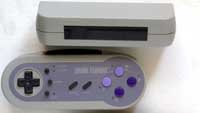 I also have an infra-red cordless controller called the Dual Turbo,
make by Acclaim.
The design of the IR receiver unit is quite clever; it plugs into the two
controller ports on the front of the console.
Because the two ports are arranged symmetrically, it can be plugged in
either way round and still work properly!
It takes four AAA batteries in each controller, although I don't
know how long they last in use.
This one has the fire buttons coloured in the US style,
in two shades of purple.
I also have an infra-red cordless controller called the Dual Turbo,
make by Acclaim.
The design of the IR receiver unit is quite clever; it plugs into the two
controller ports on the front of the console.
Because the two ports are arranged symmetrically, it can be plugged in
either way round and still work properly!
It takes four AAA batteries in each controller, although I don't
know how long they last in use.
This one has the fire buttons coloured in the US style,
in two shades of purple.
 For driving games, I have a FreeWheel controller by Logic 3,
which uses mercury switches to sense rotation and tilting of
a steering wheel.
All the usual SNES buttons are present, for game starting and
functions such as gear changing.
Again, the four fire buttons are identified by colour coding.
For driving games, I have a FreeWheel controller by Logic 3,
which uses mercury switches to sense rotation and tilting of
a steering wheel.
All the usual SNES buttons are present, for game starting and
functions such as gear changing.
Again, the four fire buttons are identified by colour coding.
 Finally, there's the SNES Mouse, supplied with Mario Paint.
It's a fairly ordinary two button opto-mechanical mouse with
a SNES interface.
The two mouse buttons are purple.
Finally, there's the SNES Mouse, supplied with Mario Paint.
It's a fairly ordinary two button opto-mechanical mouse with
a SNES interface.
The two mouse buttons are purple.
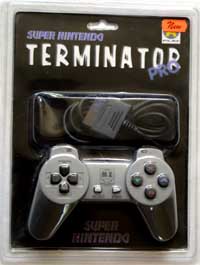 Here's an example of one game system's design influencing another.
It's a SNES joypad, but built in the style of a PlayStation
joypad.
I found it in a charity shop in Bristol, in its original
packaging.
Here's an example of one game system's design influencing another.
It's a SNES joypad, but built in the style of a PlayStation
joypad.
I found it in a charity shop in Bristol, in its original
packaging.
The Sega Mega Drive Joypad
 The Sega Mega Drive was a 68000-based console, and its joypad had three
fire buttons.
The game-start controls on this machine are reduced to a single
‘Start’ button.
The Sega Mega Drive was a 68000-based console, and its joypad had three
fire buttons.
The game-start controls on this machine are reduced to a single
‘Start’ button.
The Sony PlayStation I Joypad
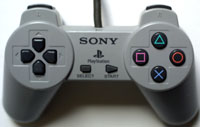 A digital joypad with two game-start buttons and eight fire buttons.
The Sony PlayStation controller adds more shoulder buttons to the SNES pad,
as well as having a even more ergonomic shape.
The interface to the console involves a complex protocol but only
a few wires.
A digital joypad with two game-start buttons and eight fire buttons.
The Sony PlayStation controller adds more shoulder buttons to the SNES pad,
as well as having a even more ergonomic shape.
The interface to the console involves a complex protocol but only
a few wires.
 Here's an alternative controller for the original PlayStation,
used mainly for driving games.
It's the NeoCon, made by Namco.
The controller has a spring-loaded twisting joint in the middle,
which lets the player twist the two halves of the controller in
opposite directions.
This controls the steering in a driving game, while the two red
buttons are analog sensors (8-bit resolution) and can control throttle and
brake in the game.
The left-hand shoulder button is also analog, but the right-hand one
is simply a digital switch.
Some controllers in the form of steering wheel and pedals seem to emulate
the NeoCon, so it's possible that Sony originally specified a generic
‘driving controller’ for games that require it.
Here's an alternative controller for the original PlayStation,
used mainly for driving games.
It's the NeoCon, made by Namco.
The controller has a spring-loaded twisting joint in the middle,
which lets the player twist the two halves of the controller in
opposite directions.
This controls the steering in a driving game, while the two red
buttons are analog sensors (8-bit resolution) and can control throttle and
brake in the game.
The left-hand shoulder button is also analog, but the right-hand one
is simply a digital switch.
Some controllers in the form of steering wheel and pedals seem to emulate
the NeoCon, so it's possible that Sony originally specified a generic
‘driving controller’ for games that require it.
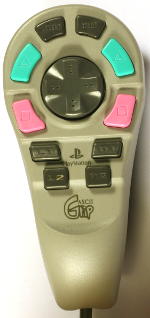 Another alternative controller, the ASCII Grip.
It's a one-handed controller, suitable for use in either the left or right hand.
There are two buttons on the bottom, circle (orange) and cross (blue).
On the top of the controller are the square (pink) and triangle (green),
duplicated on the left and right, along with the direction pad and all
the game-start buttons.
What would normally be shoulder buttons are on the lower front face of the
controller.
Another alternative controller, the ASCII Grip.
It's a one-handed controller, suitable for use in either the left or right hand.
There are two buttons on the bottom, circle (orange) and cross (blue).
On the top of the controller are the square (pink) and triangle (green),
duplicated on the left and right, along with the direction pad and all
the game-start buttons.
What would normally be shoulder buttons are on the lower front face of the
controller.
PlayStation Arcade Stick
 I'm not sure whether this big arcade-style joystick is intended for the
PlayStation or the PlayStation II,
and it has no brand name on it.
The unusual feature is that the entire group of buttons is mounted on a
rotatable platform,
so that the user can turn it to the preferred orientation.
On the left is a large arcade-style joystick.
I'm not sure whether this big arcade-style joystick is intended for the
PlayStation or the PlayStation II,
and it has no brand name on it.
The unusual feature is that the entire group of buttons is mounted on a
rotatable platform,
so that the user can turn it to the preferred orientation.
On the left is a large arcade-style joystick.
The Atari Jaguar Joypad
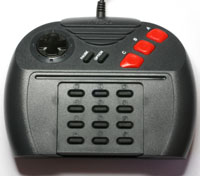 A digital joypad with two game-start buttons, three fire buttons,
a directional control pad and a numeric keypad.
The Atari Jaguar controller was introduced in 1993 and
contains a 74LS244 TTL tri-state buffer chip.
The fire buttons are labelled ‘A’, ‘B’ and ‘C’
(right to left) and are all red in colour.
A digital joypad with two game-start buttons, three fire buttons,
a directional control pad and a numeric keypad.
The Atari Jaguar controller was introduced in 1993 and
contains a 74LS244 TTL tri-state buffer chip.
The fire buttons are labelled ‘A’, ‘B’ and ‘C’
(right to left) and are all red in colour.
The Nintendo Virtual Boy Joypad
 A digital joypad with two game-start buttons, two fire buttons and
two directional control pads.
The Virtual Boy controller is unusual in that it also incorporates
the machine's batteries (AA size cells), making it rather heavy.
Introduced in 1995, the machine was not a great success.
A digital joypad with two game-start buttons, two fire buttons and
two directional control pads.
The Virtual Boy controller is unusual in that it also incorporates
the machine's batteries (AA size cells), making it rather heavy.
Introduced in 1995, the machine was not a great success.
The Sega Saturn Joypad
 The Sega Saturn controller takes a different approach to reducing
the number of wires, by adding a multiplexer.
This scheme was introduced in November 1994.
The console sends
TTL-level
signals to the joypad in order to select
which of several button inputs will be sent back.
Eight button inputs can be read in this manner.
The three larger buttons are labelled ‘A’,
‘B’ and ‘C’ while the smaller ones are
‘X’, ‘Y’ and ‘Z’.
Thanks to Maarten Foukhar for the photo.
The Sega Saturn controller takes a different approach to reducing
the number of wires, by adding a multiplexer.
This scheme was introduced in November 1994.
The console sends
TTL-level
signals to the joypad in order to select
which of several button inputs will be sent back.
Eight button inputs can be read in this manner.
The three larger buttons are labelled ‘A’,
‘B’ and ‘C’ while the smaller ones are
‘X’, ‘Y’ and ‘Z’.
Thanks to Maarten Foukhar for the photo.
The Nintendo 64 Joypad
 A bizarre three-handled controller, available in several bright colours
in addition to the standard grey.
Introduced in 1996 and featuring both a digital direction pad and
an analogue joystick.
The analog-to-digital converter (ADC) for the joystick is loacted within
the controller, and only digital signals are sent over the interface.
Again, a complex signalling protocol between console and controller.
The plug has just three pins, two for power and one signal pin.
An optional vibration pack was available that clipped onto the back
of the controller.
Power for the vibration effect was supplied by a battery in the pack,
probably because the motor would draw too much current from the
joypad's 3.3V supply.
A bizarre three-handled controller, available in several bright colours
in addition to the standard grey.
Introduced in 1996 and featuring both a digital direction pad and
an analogue joystick.
The analog-to-digital converter (ADC) for the joystick is loacted within
the controller, and only digital signals are sent over the interface.
Again, a complex signalling protocol between console and controller.
The plug has just three pins, two for power and one signal pin.
An optional vibration pack was available that clipped onto the back
of the controller.
Power for the vibration effect was supplied by a battery in the pack,
probably because the motor would draw too much current from the
joypad's 3.3V supply.

The bright yellow version of the N64 controller.
 The other photo is a third-party controller in black with a quite
different design from the original N64 version.
Not visible in the photos is the trigger-like fire button located
underneath the controller and labelled ‘Z’.
The other photo is a third-party controller in black with a quite
different design from the original N64 version.
Not visible in the photos is the trigger-like fire button located
underneath the controller and labelled ‘Z’.
The SpaceOrb 360 Controller
 Derived from the very expensive Unix workstation spaceball controller,
the SpaceOrb 360 is a six degree-of-freedom input device.
It has six buttons, labelled ‘A’ to ‘F’,
two of which are shoulder buttons (not clearly visible in the photo).
But the main control is the big rubber ball on the left,
which can be twisted in any direction,
as well as pushed in any direction (against spring pressure).
This controller is unusual in that it has a serial (RS-232) interface.
Derived from the very expensive Unix workstation spaceball controller,
the SpaceOrb 360 is a six degree-of-freedom input device.
It has six buttons, labelled ‘A’ to ‘F’,
two of which are shoulder buttons (not clearly visible in the photo).
But the main control is the big rubber ball on the left,
which can be twisted in any direction,
as well as pushed in any direction (against spring pressure).
This controller is unusual in that it has a serial (RS-232) interface.
The Tiger R-Zone

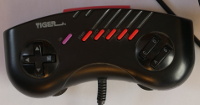 The Tiger R-Zone controller is permanently wired to the head-worn
display unit.
It has a four-way directional pad and four buttons,
labelled ‘A’ to ‘D’.
The Tiger R-Zone controller is permanently wired to the head-worn
display unit.
It has a four-way directional pad and four buttons,
labelled ‘A’ to ‘D’.
The Sony PlayStation II Joypad
 An update to the PlayStation I controller that adds
analog controls and a pair of vibration motors.
Once again, the analog-to-digital converter (ADC) is in the controller
and the interface is digital.
The two motors are fitted with eccentric weights of different
sizes, and can be independently controlled by the game.
The motor with the smaller weight can only be switched on and off,
but the larger one can operate at a variable speed as well.
For a great example of this, try the game ‘Rez’.
An update to the PlayStation I controller that adds
analog controls and a pair of vibration motors.
Once again, the analog-to-digital converter (ADC) is in the controller
and the interface is digital.
The two motors are fitted with eccentric weights of different
sizes, and can be independently controlled by the game.
The motor with the smaller weight can only be switched on and off,
but the larger one can operate at a variable speed as well.
For a great example of this, try the game ‘Rez’.
The Sega Dreamcast Joypad
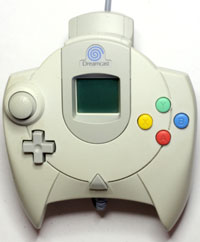 The Sega Dreamcast controller includes a slot for the memory card and
another slot for an add-on vibration pack.
Both these add-ons are install in the photo.
Note the colour coding of the buttons; the same colours are used
as on the SNES controller, but in different places.
There are now two direction pads, one analog (the round one)
and the other digital (the cruciform one).
Two gun-like triggers are located under the controller.
The Sega Dreamcast controller includes a slot for the memory card and
another slot for an add-on vibration pack.
Both these add-ons are install in the photo.
Note the colour coding of the buttons; the same colours are used
as on the SNES controller, but in different places.
There are now two direction pads, one analog (the round one)
and the other digital (the cruciform one).
Two gun-like triggers are located under the controller.
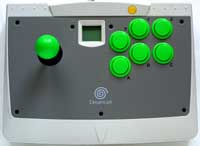 Like the NES and SNES, an arcade-style joystick was available
as an option.
On this version of the controller, all the buttons are green.
Like the NES and SNES, an arcade-style joystick was available
as an option.
On this version of the controller, all the buttons are green.
The Nintendo GameCube Joypad
 We come right up-to-date with the GameCube controller, which has
both analog and digital controls as well as a vibration motor.
Same bit-level protocol as the N64 controller, but sends and
receives more bits (25 bits to the controller, 65 bits to the
console).
Power for the vibration motor is supplied separately at 5V,
eliminating the battery that was used in the N64 version.
We come right up-to-date with the GameCube controller, which has
both analog and digital controls as well as a vibration motor.
Same bit-level protocol as the N64 controller, but sends and
receives more bits (25 bits to the controller, 65 bits to the
console).
Power for the vibration motor is supplied separately at 5V,
eliminating the battery that was used in the N64 version.
The Microsoft Xbox Joypad
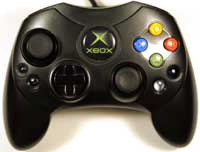 The controllers for the Microsoft Xbox have started some
controversy over their size.
The U.S. and European controllers are larger than the Japanese
version, and some people find the larger type too big.
The interface is USB, but with a non-standard connector (a
common theme with game controllers).
Wireless controllers are available for the Xbox in addition to
the standard wired types.
The controllers for the Microsoft Xbox have started some
controversy over their size.
The U.S. and European controllers are larger than the Japanese
version, and some people find the larger type too big.
The interface is USB, but with a non-standard connector (a
common theme with game controllers).
Wireless controllers are available for the Xbox in addition to
the standard wired types.
The Microsoft Xbox 360 Joypad
 The standard controllers for the Microsoft Xbox 360 are wireless,
but the photo shows the optional wired type.
Not visible in the photo are the two shoulder buttons,
in addition to the two triggers.
On the front of the controller, there's a tiny connector for
what looks like a jack plug (centre) and two two-pin plugs
(left and right).
The "X" logo lights up to indicate which of the four players
this controller belongs to.
The black and white buttons of the old Xbox controller are not
present on the Xbox 360 version.
Also missing are the two connectors for memory modules.
The interface is USB, and the vendor/product ID is 045E:028E.
The standard controllers for the Microsoft Xbox 360 are wireless,
but the photo shows the optional wired type.
Not visible in the photo are the two shoulder buttons,
in addition to the two triggers.
On the front of the controller, there's a tiny connector for
what looks like a jack plug (centre) and two two-pin plugs
(left and right).
The "X" logo lights up to indicate which of the four players
this controller belongs to.
The black and white buttons of the old Xbox controller are not
present on the Xbox 360 version.
Also missing are the two connectors for memory modules.
The interface is USB, and the vendor/product ID is 045E:028E.
Hand-held Game Controls
Hand-held games tend to have slightly simpler controls than the TV-based
consoles.
There's usually a four-way joypad and just two fire buttons.
Did any hand-held ever include a tilt-operated control?
Or a shake-operated one?
The Nintendo Game Boy
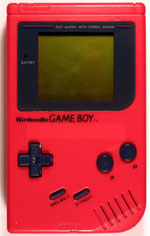 The Z80-based Game Boy was first produced in 1989 and was the machine
that popularised the game of Tetris.
It has the same controls as the NES, namely a four-way joypad, two
fire buttons and two game-control buttons.
There's no need here to minimise the wiring between joypad and game
CPU,
simply because they're both in the same box.
It's powered by four AA-size cells (the Game Boy Pocket only needed
two AAA-size cells).
My example is one of the brightly-coloured versions that were produced.
The Z80-based Game Boy was first produced in 1989 and was the machine
that popularised the game of Tetris.
It has the same controls as the NES, namely a four-way joypad, two
fire buttons and two game-control buttons.
There's no need here to minimise the wiring between joypad and game
CPU,
simply because they're both in the same box.
It's powered by four AA-size cells (the Game Boy Pocket only needed
two AAA-size cells).
My example is one of the brightly-coloured versions that were produced.
The Nintendo Game Boy Color
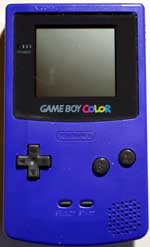 The Game Boy was updated to incorporate a colour display,
and named the Game Boy Color.
Same controls as the earlier version, just a direction pad,
two fire buttons (‘A’ and ‘B’) and
two game-control buttons (‘Select’ and ‘Start’).
It's powered by two AA-size cells.
My example is one of the brightly-coloured versions.
The Game Boy was updated to incorporate a colour display,
and named the Game Boy Color.
Same controls as the earlier version, just a direction pad,
two fire buttons (‘A’ and ‘B’) and
two game-control buttons (‘Select’ and ‘Start’).
It's powered by two AA-size cells.
My example is one of the brightly-coloured versions.
The Atari Lynx
 The Atari Lynx has a 65SC02 CPU and a colour LCD with backlight.
Similar controls to the other handhelds, just a direction pad,
two fire buttons (‘A’ and ‘B’) and
three game-control buttons
(‘Restart’, ‘Option 1’ and ‘Option 2’).
But the interesting feature is that the display can be flipped upside-down
using the ‘Flip’ button combination.
That allows the user to turn the device around the use it left-handed.
For that reason, the ‘A’ and ‘B’ buttons are
duplicated.
Introduced in Europe in 1990.
It's powered by six AA-size cells.
The Atari Lynx has a 65SC02 CPU and a colour LCD with backlight.
Similar controls to the other handhelds, just a direction pad,
two fire buttons (‘A’ and ‘B’) and
three game-control buttons
(‘Restart’, ‘Option 1’ and ‘Option 2’).
But the interesting feature is that the display can be flipped upside-down
using the ‘Flip’ button combination.
That allows the user to turn the device around the use it left-handed.
For that reason, the ‘A’ and ‘B’ buttons are
duplicated.
Introduced in Europe in 1990.
It's powered by six AA-size cells.
The Sega Game Gear
 The Sega Game Gear has a Z80 CPU and a colour LCD.
Similar controls to the other handhelds, just a direction pad,
two fire buttons (‘1’ and ‘2’) and
one game-control button (‘Start’).
Introduced in Europe in 1991.
It's powered by six AA-size cells placed in two groups of three for
even weight distribution.
The Sega Game Gear has a Z80 CPU and a colour LCD.
Similar controls to the other handhelds, just a direction pad,
two fire buttons (‘1’ and ‘2’) and
one game-control button (‘Start’).
Introduced in Europe in 1991.
It's powered by six AA-size cells placed in two groups of three for
even weight distribution.
The Game Park GP32
 Right up-to-date now with the ARM-based GP32 from Game Park in Korea.
Very similar control setup to the Game Boy, though, with Start, Select,
A, B and two shoulder buttons, as well as a four-way joypad.
Right up-to-date now with the ARM-based GP32 from Game Park in Korea.
Very similar control setup to the Game Boy, though, with Start, Select,
A, B and two shoulder buttons, as well as a four-way joypad.
The Nintendo Game Boy Advance SP
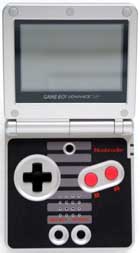 Staying with modern hand-helds, and the ARM chip, this is the Nintendo
Game Boy Advance SP.
My example is the retro-styled version that imitates the original
NES joypad.
The controls are familiar from the earlier Game Boy, with the addition
of two shoulder buttons (not visible in the photo).
Staying with modern hand-helds, and the ARM chip, this is the Nintendo
Game Boy Advance SP.
My example is the retro-styled version that imitates the original
NES joypad.
The controls are familiar from the earlier Game Boy, with the addition
of two shoulder buttons (not visible in the photo).
Links to other joystick, game pad and game controller archives
 An analogue control based on the monostable and triggered by
the frame sync pulse.
This particular one with the snazzy orange plastic case is from the
Binatone TV Master MK IV.
Game-start buttons were often located on the console, not on the
paddles.
Some TV games didn't even put the paddles on wires, but placed
them on the front of the game box itself.
One particularly odd machine in this respect was the Videomaster
Superscore, which not only mounted the controls on the front
of the console,
but it also used roller-style controls.
An analogue control based on the monostable and triggered by
the frame sync pulse.
This particular one with the snazzy orange plastic case is from the
Binatone TV Master MK IV.
Game-start buttons were often located on the console, not on the
paddles.
Some TV games didn't even put the paddles on wires, but placed
them on the front of the game box itself.
One particularly odd machine in this respect was the Videomaster
Superscore, which not only mounted the controls on the front
of the console,
but it also used roller-style controls.
 Another slightly strange option was the use of slider controls,
such as those on the Commodore 3000H TV Game.
One slider, labelled ‘Bat Control’ was located on the
console itself, while the other slider was in a separate hand-held box.
My example is a PAL version and is labelled in German as well as English.
Another slightly strange option was the use of slider controls,
such as those on the Commodore 3000H TV Game.
One slider, labelled ‘Bat Control’ was located on the
console itself, while the other slider was in a separate hand-held box.
My example is a PAL version and is labelled in German as well as English.
 Inside the Commodore slider paddle, there's simply a 1MΩ
potentiometer, wired up as a variable resistor.
Two additional sliders connected to a single 5-pin DIN plug for
four-player games.
Inside the Commodore slider paddle, there's simply a 1MΩ
potentiometer, wired up as a variable resistor.
Two additional sliders connected to a single 5-pin DIN plug for
four-player games.
 Generally, with the early TV tennis games, there were no buttons on the paddles.
These paddles were made by Atari and have a side-mounted button as well as
the usual rotary paddle control.
Thanks to Maarten Foukhar for the photo.
Generally, with the early TV tennis games, there were no buttons on the paddles.
These paddles were made by Atari and have a side-mounted button as well as
the usual rotary paddle control.
Thanks to Maarten Foukhar for the photo.
 A digital, four-way joystick with a single fire button.
Introduced in October 1977 with the Atari Video Computer System (VCS),
later renamed the Atari 2600.
Set the standard in joysticks and interface connectors for many years.
Again, game-start controls on the console itself.
Need photos: Quick Shot joystick.
A digital, four-way joystick with a single fire button.
Introduced in October 1977 with the Atari Video Computer System (VCS),
later renamed the Atari 2600.
Set the standard in joysticks and interface connectors for many years.
Again, game-start controls on the console itself.
Need photos: Quick Shot joystick.
 Many manufacturers made Atari-compatible joysticks with four direction
switches and a fire button.
Here's an example in clear plastic, where the user can see the four
high-quality microswitches at the bottom of the stick.
Shame they didn't use a microswitch for the fire button, too.
Many manufacturers made Atari-compatible joysticks with four direction
switches and a fire button.
Here's an example in clear plastic, where the user can see the four
high-quality microswitches at the bottom of the stick.
Shame they didn't use a microswitch for the fire button, too.
 Spectravideo made a wide range of joysticks and other game controllers
under the Quick Shot brand.
This one is the Quick Shot VII, a joystick with a moving pad
instead of a stick.
It also has two shoulder buttons,
but it's not clear how you're supposed to hold it.
Is it intended to be used one-handed?
And which way up does it go?
In addition to the buttons, it has two red LEDs.
I should really plug this one into a console and see what the LEDs do.
Spectravideo made a wide range of joysticks and other game controllers
under the Quick Shot brand.
This one is the Quick Shot VII, a joystick with a moving pad
instead of a stick.
It also has two shoulder buttons,
but it's not clear how you're supposed to hold it.
Is it intended to be used one-handed?
And which way up does it go?
In addition to the buttons, it has two red LEDs.
I should really plug this one into a console and see what the LEDs do.
 Another from Spectravideo,
this one is the Quick Shot IX, a joystick in the shape of a ball.
It has two buttons in addition to the four-way switches underneath the
ball, which is in fact a hemisphere.
It looks like a trackball, but it isn't.
There's a slide switch on one side that's marked ‘LEFT HAND’
and ‘RIGHT HAND’ -- I presume it swaps the buttons around.
The interface is a 9-pin D-connector like the Atari joystick above,
although I think other models were made with different interfaces.
Another from Spectravideo,
this one is the Quick Shot IX, a joystick in the shape of a ball.
It has two buttons in addition to the four-way switches underneath the
ball, which is in fact a hemisphere.
It looks like a trackball, but it isn't.
There's a slide switch on one side that's marked ‘LEFT HAND’
and ‘RIGHT HAND’ -- I presume it swaps the buttons around.
The interface is a 9-pin D-connector like the Atari joystick above,
although I think other models were made with different interfaces.
 The Atari 7800 controller is a digital, four-way joystick with two fire buttons.
Simply adds an extra fire button to the 2600 joystick.
The wiring is cleverly arranged to maintain compatibility with
the older 2600 joystick, with just a couple of resistors forming
a crude OR gate.
My example is missing the screw-in stick, but still functions
as a joypad.
Buttons are labelled ‘1’ and ‘2’.
The Atari 7800 controller is a digital, four-way joystick with two fire buttons.
Simply adds an extra fire button to the 2600 joystick.
The wiring is cleverly arranged to maintain compatibility with
the older 2600 joystick, with just a couple of resistors forming
a crude OR gate.
My example is missing the screw-in stick, but still functions
as a joypad.
Buttons are labelled ‘1’ and ‘2’.
 A peculiar gadget, the QJ Footpedal System was designed to work with
the Atari joysticks and other compatible machines.
It has three foot-operated switches, as well as a set of configuration
switches.
You could set it up to operate a driving game, presumably.
QJ model SV-129, patent pending.
A peculiar gadget, the QJ Footpedal System was designed to work with
the Atari joysticks and other compatible machines.
It has three foot-operated switches, as well as a set of configuration
switches.
You could set it up to operate a driving game, presumably.
QJ model SV-129, patent pending.
 An analog joystick with a single fire button.
Many UK gamers would remember the
BBC
Micro and its 15-pin analog port,
which was usually used for a joystick.
However, other machines had similar (but incompatible) ports,
such as the Dragon 32.
Games were generally started from the
BASIC
interpreter of the machine, using the keyboard.
Need photos: Dragon joystick, Apple ][ paddle.
An analog joystick with a single fire button.
Many UK gamers would remember the
BBC
Micro and its 15-pin analog port,
which was usually used for a joystick.
However, other machines had similar (but incompatible) ports,
such as the Dragon 32.
Games were generally started from the
BASIC
interpreter of the machine, using the keyboard.
Need photos: Dragon joystick, Apple ][ paddle.
 An analog joystick with four buttons.
The Vectrex was an 8-bit, vector-scan console introduced in 1982.
It had two controller ports, and each controller had an analog
joystick (sprung to centre) and four buttons.
The analog-to-digital converter (ADC) for the joystick was located in
the console itself, not in the controller, and two wires carry the analog
signals through the cable to the 9-pin plug.
The function of the buttons was shown on the screen overlay.
Games were started from the controller using the normal fire buttons.
The four buttons are labelled ‘1’ to ‘4’.
An analog joystick with four buttons.
The Vectrex was an 8-bit, vector-scan console introduced in 1982.
It had two controller ports, and each controller had an analog
joystick (sprung to centre) and four buttons.
The analog-to-digital converter (ADC) for the joystick was located in
the console itself, not in the controller, and two wires carry the analog
signals through the cable to the 9-pin plug.
The function of the buttons was shown on the screen overlay.
Games were started from the controller using the normal fire buttons.
The four buttons are labelled ‘1’ to ‘4’.
 A digital joypad with two game-start buttons and two fire buttons.
First used on the Nintendo Family Computer of 1983, and later
sold around the world as the Nintendo Entertainment System (NES)
from 1986.
The NES joypad introduces the idea of placing active components
and circuitry inside the joypad.
Each joypad has an 8-bit
CMOS
shift register chip in it (the 4021)
and the console contains hardware to communicate with it.
This reduces the number of wires required in the cable from
nine (one per button, plus ground) to just five.
However, the NES has a seven-pin connector
(the two extra pins were for the light gun).
The shape of the game pad, however, is a very basic rectangular box.
The two fire buttons are both red in colour and are labelled
‘A’ and ‘B’.
A digital joypad with two game-start buttons and two fire buttons.
First used on the Nintendo Family Computer of 1983, and later
sold around the world as the Nintendo Entertainment System (NES)
from 1986.
The NES joypad introduces the idea of placing active components
and circuitry inside the joypad.
Each joypad has an 8-bit
CMOS
shift register chip in it (the 4021)
and the console contains hardware to communicate with it.
This reduces the number of wires required in the cable from
nine (one per button, plus ground) to just five.
However, the NES has a seven-pin connector
(the two extra pins were for the light gun).
The shape of the game pad, however, is a very basic rectangular box.
The two fire buttons are both red in colour and are labelled
‘A’ and ‘B’.
 The NES Advantage was a much larger, arcade-style joystick for the NES console.
It has a double cable and can be switched between acting as the
‘Player 1’ controls and the ‘Player 2’ controls.
It also features variable speed auto-repeat on the fire buttons.
The NES Advantage was a much larger, arcade-style joystick for the NES console.
It has a double cable and can be switched between acting as the
‘Player 1’ controls and the ‘Player 2’ controls.
It also features variable speed auto-repeat on the fire buttons.
 The light gun for the NES was officially called the NES Zapper.
This example has the optional add-on gunsight, clipped on top.
The light gun for the NES was officially called the NES Zapper.
This example has the optional add-on gunsight, clipped on top.
 A digital joypad with two game-start buttons and six fire buttons.
The Super Nintendo Entertainment Sysytem joypad extends the
8-bit shift register of the NES to 16 bits,
although only 12 bits were actually used.
Exactly the same interface circuit will read a SNES pad as was
used for the NES, simply clocking the shift register 12 times
instead of eight.
There's also a different connector on the SNES pad, but the same number
of active wires in the cable: five.
It also introduces the idea of shoulder buttons, and it is shaped
much more naturally to fit the player's hands.
A digital joypad with two game-start buttons and six fire buttons.
The Super Nintendo Entertainment Sysytem joypad extends the
8-bit shift register of the NES to 16 bits,
although only 12 bits were actually used.
Exactly the same interface circuit will read a SNES pad as was
used for the NES, simply clocking the shift register 12 times
instead of eight.
There's also a different connector on the SNES pad, but the same number
of active wires in the cable: five.
It also introduces the idea of shoulder buttons, and it is shaped
much more naturally to fit the player's hands.
 Like the NES, an arcade-style joystick was available, called the
Score Master.
This joystick includes the two shoulder buttons of the original,
but moves them into the same group as the main four fire buttons.
The fire buttons retain their usual colour coding, while the two shoulder
buttons are grey.
Like the NES, an arcade-style joystick was available, called the
Score Master.
This joystick includes the two shoulder buttons of the original,
but moves them into the same group as the main four fire buttons.
The fire buttons retain their usual colour coding, while the two shoulder
buttons are grey.
 I also have an infra-red cordless controller called the Dual Turbo,
make by Acclaim.
The design of the IR receiver unit is quite clever; it plugs into the two
controller ports on the front of the console.
Because the two ports are arranged symmetrically, it can be plugged in
either way round and still work properly!
It takes four AAA batteries in each controller, although I don't
know how long they last in use.
This one has the fire buttons coloured in the US style,
in two shades of purple.
I also have an infra-red cordless controller called the Dual Turbo,
make by Acclaim.
The design of the IR receiver unit is quite clever; it plugs into the two
controller ports on the front of the console.
Because the two ports are arranged symmetrically, it can be plugged in
either way round and still work properly!
It takes four AAA batteries in each controller, although I don't
know how long they last in use.
This one has the fire buttons coloured in the US style,
in two shades of purple.
 For driving games, I have a FreeWheel controller by Logic 3,
which uses mercury switches to sense rotation and tilting of
a steering wheel.
All the usual SNES buttons are present, for game starting and
functions such as gear changing.
Again, the four fire buttons are identified by colour coding.
For driving games, I have a FreeWheel controller by Logic 3,
which uses mercury switches to sense rotation and tilting of
a steering wheel.
All the usual SNES buttons are present, for game starting and
functions such as gear changing.
Again, the four fire buttons are identified by colour coding.
 Finally, there's the SNES Mouse, supplied with Mario Paint.
It's a fairly ordinary two button opto-mechanical mouse with
a SNES interface.
The two mouse buttons are purple.
Finally, there's the SNES Mouse, supplied with Mario Paint.
It's a fairly ordinary two button opto-mechanical mouse with
a SNES interface.
The two mouse buttons are purple.
 Here's an example of one game system's design influencing another.
It's a SNES joypad, but built in the style of a PlayStation
joypad.
I found it in a charity shop in Bristol, in its original
packaging.
Here's an example of one game system's design influencing another.
It's a SNES joypad, but built in the style of a PlayStation
joypad.
I found it in a charity shop in Bristol, in its original
packaging.
 The Sega Mega Drive was a 68000-based console, and its joypad had three
fire buttons.
The game-start controls on this machine are reduced to a single
‘Start’ button.
The Sega Mega Drive was a 68000-based console, and its joypad had three
fire buttons.
The game-start controls on this machine are reduced to a single
‘Start’ button.
 A digital joypad with two game-start buttons and eight fire buttons.
The Sony PlayStation controller adds more shoulder buttons to the SNES pad,
as well as having a even more ergonomic shape.
The interface to the console involves a complex protocol but only
a few wires.
A digital joypad with two game-start buttons and eight fire buttons.
The Sony PlayStation controller adds more shoulder buttons to the SNES pad,
as well as having a even more ergonomic shape.
The interface to the console involves a complex protocol but only
a few wires.
 Here's an alternative controller for the original PlayStation,
used mainly for driving games.
It's the NeoCon, made by Namco.
The controller has a spring-loaded twisting joint in the middle,
which lets the player twist the two halves of the controller in
opposite directions.
This controls the steering in a driving game, while the two red
buttons are analog sensors (8-bit resolution) and can control throttle and
brake in the game.
The left-hand shoulder button is also analog, but the right-hand one
is simply a digital switch.
Some controllers in the form of steering wheel and pedals seem to emulate
the NeoCon, so it's possible that Sony originally specified a generic
‘driving controller’ for games that require it.
Here's an alternative controller for the original PlayStation,
used mainly for driving games.
It's the NeoCon, made by Namco.
The controller has a spring-loaded twisting joint in the middle,
which lets the player twist the two halves of the controller in
opposite directions.
This controls the steering in a driving game, while the two red
buttons are analog sensors (8-bit resolution) and can control throttle and
brake in the game.
The left-hand shoulder button is also analog, but the right-hand one
is simply a digital switch.
Some controllers in the form of steering wheel and pedals seem to emulate
the NeoCon, so it's possible that Sony originally specified a generic
‘driving controller’ for games that require it.
 Another alternative controller, the ASCII Grip.
It's a one-handed controller, suitable for use in either the left or right hand.
There are two buttons on the bottom, circle (orange) and cross (blue).
On the top of the controller are the square (pink) and triangle (green),
duplicated on the left and right, along with the direction pad and all
the game-start buttons.
What would normally be shoulder buttons are on the lower front face of the
controller.
Another alternative controller, the ASCII Grip.
It's a one-handed controller, suitable for use in either the left or right hand.
There are two buttons on the bottom, circle (orange) and cross (blue).
On the top of the controller are the square (pink) and triangle (green),
duplicated on the left and right, along with the direction pad and all
the game-start buttons.
What would normally be shoulder buttons are on the lower front face of the
controller.
 I'm not sure whether this big arcade-style joystick is intended for the
PlayStation or the PlayStation II,
and it has no brand name on it.
The unusual feature is that the entire group of buttons is mounted on a
rotatable platform,
so that the user can turn it to the preferred orientation.
On the left is a large arcade-style joystick.
I'm not sure whether this big arcade-style joystick is intended for the
PlayStation or the PlayStation II,
and it has no brand name on it.
The unusual feature is that the entire group of buttons is mounted on a
rotatable platform,
so that the user can turn it to the preferred orientation.
On the left is a large arcade-style joystick.
 A digital joypad with two game-start buttons, three fire buttons,
a directional control pad and a numeric keypad.
The Atari Jaguar controller was introduced in 1993 and
contains a 74LS244 TTL tri-state buffer chip.
The fire buttons are labelled ‘A’, ‘B’ and ‘C’
(right to left) and are all red in colour.
A digital joypad with two game-start buttons, three fire buttons,
a directional control pad and a numeric keypad.
The Atari Jaguar controller was introduced in 1993 and
contains a 74LS244 TTL tri-state buffer chip.
The fire buttons are labelled ‘A’, ‘B’ and ‘C’
(right to left) and are all red in colour.
 A digital joypad with two game-start buttons, two fire buttons and
two directional control pads.
The Virtual Boy controller is unusual in that it also incorporates
the machine's batteries (AA size cells), making it rather heavy.
Introduced in 1995, the machine was not a great success.
A digital joypad with two game-start buttons, two fire buttons and
two directional control pads.
The Virtual Boy controller is unusual in that it also incorporates
the machine's batteries (AA size cells), making it rather heavy.
Introduced in 1995, the machine was not a great success.
 The Sega Saturn controller takes a different approach to reducing
the number of wires, by adding a multiplexer.
This scheme was introduced in November 1994.
The console sends
TTL-level
signals to the joypad in order to select
which of several button inputs will be sent back.
Eight button inputs can be read in this manner.
The three larger buttons are labelled ‘A’,
‘B’ and ‘C’ while the smaller ones are
‘X’, ‘Y’ and ‘Z’.
Thanks to Maarten Foukhar for the photo.
The Sega Saturn controller takes a different approach to reducing
the number of wires, by adding a multiplexer.
This scheme was introduced in November 1994.
The console sends
TTL-level
signals to the joypad in order to select
which of several button inputs will be sent back.
Eight button inputs can be read in this manner.
The three larger buttons are labelled ‘A’,
‘B’ and ‘C’ while the smaller ones are
‘X’, ‘Y’ and ‘Z’.
Thanks to Maarten Foukhar for the photo.
 A bizarre three-handled controller, available in several bright colours
in addition to the standard grey.
Introduced in 1996 and featuring both a digital direction pad and
an analogue joystick.
The analog-to-digital converter (ADC) for the joystick is loacted within
the controller, and only digital signals are sent over the interface.
Again, a complex signalling protocol between console and controller.
The plug has just three pins, two for power and one signal pin.
An optional vibration pack was available that clipped onto the back
of the controller.
Power for the vibration effect was supplied by a battery in the pack,
probably because the motor would draw too much current from the
joypad's 3.3V supply.
A bizarre three-handled controller, available in several bright colours
in addition to the standard grey.
Introduced in 1996 and featuring both a digital direction pad and
an analogue joystick.
The analog-to-digital converter (ADC) for the joystick is loacted within
the controller, and only digital signals are sent over the interface.
Again, a complex signalling protocol between console and controller.
The plug has just three pins, two for power and one signal pin.
An optional vibration pack was available that clipped onto the back
of the controller.
Power for the vibration effect was supplied by a battery in the pack,
probably because the motor would draw too much current from the
joypad's 3.3V supply.

 The other photo is a third-party controller in black with a quite
different design from the original N64 version.
Not visible in the photos is the trigger-like fire button located
underneath the controller and labelled ‘Z’.
The other photo is a third-party controller in black with a quite
different design from the original N64 version.
Not visible in the photos is the trigger-like fire button located
underneath the controller and labelled ‘Z’.
 Derived from the very expensive Unix workstation spaceball controller,
the SpaceOrb 360 is a six degree-of-freedom input device.
It has six buttons, labelled ‘A’ to ‘F’,
two of which are shoulder buttons (not clearly visible in the photo).
But the main control is the big rubber ball on the left,
which can be twisted in any direction,
as well as pushed in any direction (against spring pressure).
This controller is unusual in that it has a serial (RS-232) interface.
Derived from the very expensive Unix workstation spaceball controller,
the SpaceOrb 360 is a six degree-of-freedom input device.
It has six buttons, labelled ‘A’ to ‘F’,
two of which are shoulder buttons (not clearly visible in the photo).
But the main control is the big rubber ball on the left,
which can be twisted in any direction,
as well as pushed in any direction (against spring pressure).
This controller is unusual in that it has a serial (RS-232) interface.

 The Tiger R-Zone controller is permanently wired to the head-worn
display unit.
It has a four-way directional pad and four buttons,
labelled ‘A’ to ‘D’.
The Tiger R-Zone controller is permanently wired to the head-worn
display unit.
It has a four-way directional pad and four buttons,
labelled ‘A’ to ‘D’.
 An update to the PlayStation I controller that adds
analog controls and a pair of vibration motors.
Once again, the analog-to-digital converter (ADC) is in the controller
and the interface is digital.
The two motors are fitted with eccentric weights of different
sizes, and can be independently controlled by the game.
The motor with the smaller weight can only be switched on and off,
but the larger one can operate at a variable speed as well.
For a great example of this, try the game ‘Rez’.
An update to the PlayStation I controller that adds
analog controls and a pair of vibration motors.
Once again, the analog-to-digital converter (ADC) is in the controller
and the interface is digital.
The two motors are fitted with eccentric weights of different
sizes, and can be independently controlled by the game.
The motor with the smaller weight can only be switched on and off,
but the larger one can operate at a variable speed as well.
For a great example of this, try the game ‘Rez’.
 The Sega Dreamcast controller includes a slot for the memory card and
another slot for an add-on vibration pack.
Both these add-ons are install in the photo.
Note the colour coding of the buttons; the same colours are used
as on the SNES controller, but in different places.
There are now two direction pads, one analog (the round one)
and the other digital (the cruciform one).
Two gun-like triggers are located under the controller.
The Sega Dreamcast controller includes a slot for the memory card and
another slot for an add-on vibration pack.
Both these add-ons are install in the photo.
Note the colour coding of the buttons; the same colours are used
as on the SNES controller, but in different places.
There are now two direction pads, one analog (the round one)
and the other digital (the cruciform one).
Two gun-like triggers are located under the controller.
 Like the NES and SNES, an arcade-style joystick was available
as an option.
On this version of the controller, all the buttons are green.
Like the NES and SNES, an arcade-style joystick was available
as an option.
On this version of the controller, all the buttons are green.
 We come right up-to-date with the GameCube controller, which has
both analog and digital controls as well as a vibration motor.
Same bit-level protocol as the N64 controller, but sends and
receives more bits (25 bits to the controller, 65 bits to the
console).
Power for the vibration motor is supplied separately at 5V,
eliminating the battery that was used in the N64 version.
We come right up-to-date with the GameCube controller, which has
both analog and digital controls as well as a vibration motor.
Same bit-level protocol as the N64 controller, but sends and
receives more bits (25 bits to the controller, 65 bits to the
console).
Power for the vibration motor is supplied separately at 5V,
eliminating the battery that was used in the N64 version.
 The controllers for the Microsoft Xbox have started some
controversy over their size.
The U.S. and European controllers are larger than the Japanese
version, and some people find the larger type too big.
The interface is USB, but with a non-standard connector (a
common theme with game controllers).
Wireless controllers are available for the Xbox in addition to
the standard wired types.
The controllers for the Microsoft Xbox have started some
controversy over their size.
The U.S. and European controllers are larger than the Japanese
version, and some people find the larger type too big.
The interface is USB, but with a non-standard connector (a
common theme with game controllers).
Wireless controllers are available for the Xbox in addition to
the standard wired types.
 The standard controllers for the Microsoft Xbox 360 are wireless,
but the photo shows the optional wired type.
Not visible in the photo are the two shoulder buttons,
in addition to the two triggers.
On the front of the controller, there's a tiny connector for
what looks like a jack plug (centre) and two two-pin plugs
(left and right).
The "X" logo lights up to indicate which of the four players
this controller belongs to.
The black and white buttons of the old Xbox controller are not
present on the Xbox 360 version.
Also missing are the two connectors for memory modules.
The interface is USB, and the vendor/product ID is 045E:028E.
The standard controllers for the Microsoft Xbox 360 are wireless,
but the photo shows the optional wired type.
Not visible in the photo are the two shoulder buttons,
in addition to the two triggers.
On the front of the controller, there's a tiny connector for
what looks like a jack plug (centre) and two two-pin plugs
(left and right).
The "X" logo lights up to indicate which of the four players
this controller belongs to.
The black and white buttons of the old Xbox controller are not
present on the Xbox 360 version.
Also missing are the two connectors for memory modules.
The interface is USB, and the vendor/product ID is 045E:028E.
 The Z80-based Game Boy was first produced in 1989 and was the machine
that popularised the game of Tetris.
It has the same controls as the NES, namely a four-way joypad, two
fire buttons and two game-control buttons.
There's no need here to minimise the wiring between joypad and game
CPU,
simply because they're both in the same box.
It's powered by four AA-size cells (the Game Boy Pocket only needed
two AAA-size cells).
My example is one of the brightly-coloured versions that were produced.
The Z80-based Game Boy was first produced in 1989 and was the machine
that popularised the game of Tetris.
It has the same controls as the NES, namely a four-way joypad, two
fire buttons and two game-control buttons.
There's no need here to minimise the wiring between joypad and game
CPU,
simply because they're both in the same box.
It's powered by four AA-size cells (the Game Boy Pocket only needed
two AAA-size cells).
My example is one of the brightly-coloured versions that were produced.
 The Game Boy was updated to incorporate a colour display,
and named the Game Boy Color.
Same controls as the earlier version, just a direction pad,
two fire buttons (‘A’ and ‘B’) and
two game-control buttons (‘Select’ and ‘Start’).
It's powered by two AA-size cells.
My example is one of the brightly-coloured versions.
The Game Boy was updated to incorporate a colour display,
and named the Game Boy Color.
Same controls as the earlier version, just a direction pad,
two fire buttons (‘A’ and ‘B’) and
two game-control buttons (‘Select’ and ‘Start’).
It's powered by two AA-size cells.
My example is one of the brightly-coloured versions.
 The Atari Lynx has a 65SC02 CPU and a colour LCD with backlight.
Similar controls to the other handhelds, just a direction pad,
two fire buttons (‘A’ and ‘B’) and
three game-control buttons
(‘Restart’, ‘Option 1’ and ‘Option 2’).
But the interesting feature is that the display can be flipped upside-down
using the ‘Flip’ button combination.
That allows the user to turn the device around the use it left-handed.
For that reason, the ‘A’ and ‘B’ buttons are
duplicated.
Introduced in Europe in 1990.
It's powered by six AA-size cells.
The Atari Lynx has a 65SC02 CPU and a colour LCD with backlight.
Similar controls to the other handhelds, just a direction pad,
two fire buttons (‘A’ and ‘B’) and
three game-control buttons
(‘Restart’, ‘Option 1’ and ‘Option 2’).
But the interesting feature is that the display can be flipped upside-down
using the ‘Flip’ button combination.
That allows the user to turn the device around the use it left-handed.
For that reason, the ‘A’ and ‘B’ buttons are
duplicated.
Introduced in Europe in 1990.
It's powered by six AA-size cells.
 The Sega Game Gear has a Z80 CPU and a colour LCD.
Similar controls to the other handhelds, just a direction pad,
two fire buttons (‘1’ and ‘2’) and
one game-control button (‘Start’).
Introduced in Europe in 1991.
It's powered by six AA-size cells placed in two groups of three for
even weight distribution.
The Sega Game Gear has a Z80 CPU and a colour LCD.
Similar controls to the other handhelds, just a direction pad,
two fire buttons (‘1’ and ‘2’) and
one game-control button (‘Start’).
Introduced in Europe in 1991.
It's powered by six AA-size cells placed in two groups of three for
even weight distribution.
 Right up-to-date now with the ARM-based GP32 from Game Park in Korea.
Very similar control setup to the Game Boy, though, with Start, Select,
A, B and two shoulder buttons, as well as a four-way joypad.
Right up-to-date now with the ARM-based GP32 from Game Park in Korea.
Very similar control setup to the Game Boy, though, with Start, Select,
A, B and two shoulder buttons, as well as a four-way joypad.
 Staying with modern hand-helds, and the ARM chip, this is the Nintendo
Game Boy Advance SP.
My example is the retro-styled version that imitates the original
NES joypad.
The controls are familiar from the earlier Game Boy, with the addition
of two shoulder buttons (not visible in the photo).
Staying with modern hand-helds, and the ARM chip, this is the Nintendo
Game Boy Advance SP.
My example is the retro-styled version that imitates the original
NES joypad.
The controls are familiar from the earlier Game Boy, with the addition
of two shoulder buttons (not visible in the photo).